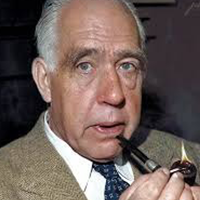Niels Bohr
Niels Henrik David Bohr was a Danish physicist who made foundational contributions to understanding atomic structure and quantum theory, for which he received the Nobel Prize in Physics in 1922. Bohr was also a philosopher and a promoter of scientific research.
[0:37 pm, 07/10/2021] +91 95351 00349: Niels Bohr was a Nobel Prize-winning physicist and humanitarian whose revolutionary theories on atomic structures helped shape research worldwide. He came up with a revolutionary theory on atomic structures and radiation emission. He won the 1922 Nobel Prize in physics for his ideas
Niels Bohr was born in Copenhagen, Denmark, to mother Ellen Adler, who was part of a successful Jewish banking clan, and father Christian Bohr, a celebrated physiology academic. The young Bohr eventually attended Copenhagen University, where he received his master’s and doctorate in physics by 1911. During the fall of the same year, Bohr traveled to Cambridge, England, where he was able to follow the Cavendish Laboratory work of scientist J.J. Thomson.
Bohr’s own research led him to theorize in a series of articles that atoms give off electromagnetic radiation as a result of electrons jumping to different orbit levels, departing from a previously held model espoused by Ernest Rutherford. After teaching at Manchester’s Victoria University, Bohr settled again at Copenhagen University in 1916 with a professorship position. Then, in 1920, he founded the university’s Institute of Theoretical Physics, which he would head for the rest of his life.
Bohr received the 1922 Nobel Prize in Physics for his work on atomic structures, and he would continue to come up with revolutionary theories. He worked with Werner Heisenberg and other scientists on a new quantum mechanics principle connected to Bohr’s concept of complementarity, which was initially presented at an Italian conference in 1927. The concept asserted that physical properties on an atomic level would be viewed differently depending on experimental parameters, hence explaining why light could be seen as both a particle and a wave, though never both at the same time. Another physicist, by the name of Albert Einstein, and their talks became renowned in scientific communities.
With Adolf Hitler’s rise in power, Bohr was able to offer German Jewish physicists refuge at his institute in Copenhagen, which in turn led to travel to the United States for many. Once Denmark became occupied by Nazi forces, the Bohr family escaped to Sweden, with Bohr and his son Aage eventually making their way to the United States. Bohr then worked with the Manhattan Project in Los Alamos, New Mexico, where the first atomic bomb was being created. Because he had concerns about how the bomb could be used, he called for future international arms control and active communication about the weapon between nations — an idea met with resistance by Winston Churchill and Franklin D. Roosevelt.
After the end of the war, Bohr returned to Europe and continued to call for peaceful applications of atomic energy. He helped to establish CERN, a Europe-based particle physics research facility, in 1954 and put together the Atoms for Peace Conference of 1955. In 1957, Bohr received the Atoms for Peace Award for his trailblazing theories and efforts to use atomic energy responsibly .Bohr was a prolific writer with more than 100 publications to his name.

Niels Bohr
Date of Birth: 07 Oct 1885
Birth Place: Copenhagen, Denmark
Proffession: Danish physicist
Nationality: Danish
Death: 18 November 1962, Carlsberg Byen Ejendomme P/S, Copenhagen, Denmark


